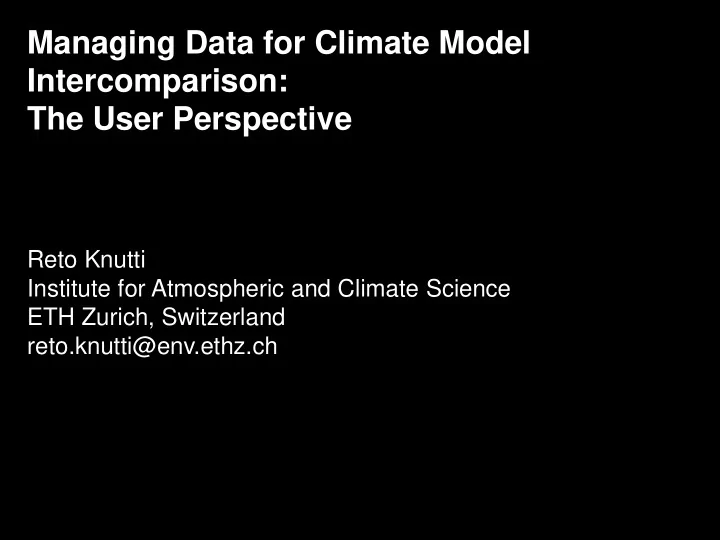

Managing Data for Climate Model Intercomparison: The User Perspective Reto Knutti Institute for Atmospheric and Climate Science ETH Zurich, Switzerland reto.knutti@env.ethz.ch
What did we learn from the latest Symptoms of hitting a wall generation of climate models? • Uncertainties in projections across models do not decrease • Criteria for a good model are unclear • Ensembles of models are hard to understand • Results are of limited value for end users • Models are slow and produce too much data • Download and analysis of data is painful
Motivation A not so unusual example Groves PCM1 2014 Slides courtesy of Rob Lempert
Challenges wrt model intercomparisons faced in IPCC and other projects • Sheer amount of data in CMIP5: ~ 3 Petabyte distributed across centers Storage and bandwidth problem • Dimensionality: lat x lon x height x time x hourly/daily/monthly x variable x mean/extreme/… x model x model version x ensemble member x scenario • Model simulations are always delayed… only weeks to produce results • Data quality: 1) technical sense (completeness, units, format), 2) scientific sense • Evolving database rather than once produced and published • Traceability, user notification • Distributed system: performance, coordination, downtime
Multimodel results therefore require some analysis platform
Analysis platform The ETH Zurich CMIP5 snapshot • Need for a single, (reasonably) quality controlled subset of CMIP5 data, immediately available, simple to use, fast, reliable, automated synchronisation to various sites • ETH Zurich archive: 100 TB, half a million files, simple directory structure • Single command synchronisation Get list of filenames and their corresponding md5 checksum and creation date rsync -vrlpt cmip5user@atmos.ethz.ch::cmip5/filelist.txt . Get monthly mean of maximum surface temperature data from historical runs: rsync -vrlpt --delete cmip5user@atmos.ethz.ch::cmip5/historical/Amon/tasmax cmip5/historical/Amon/ • Frozen in March 2013 for IPCC, now permanently archived at DKRZ
Analysis platform The ETH Zurich CMIP5 snapshot • Problem: Earth System Grid (ESG) distributed, slow, unreliable: How do we distinguish database error, file error, site down, data withdrawn, data being fixed? • Workaround: reverse engineering ESG, >20 clients running scripts to search new (and old) data 24/7, lots of scripts trying to intelligently find gaps, errors, overlaps. • Limitations of our approach: impossible for whole archive, no authentication • Advantages: users sync quickly, automated, works. Consistent dataset across groups, transparency, traceability. • General limitations of platforms: Lots of work to manually fix technical problems, No scientific evaluation! • Files changing every second: When to stop? How do we ensure quality?
Lessons learned and suggestions for future efforts • Distributed data makes sense but has been problematic • Analysis platform needed, mirrored snapshots ok for most, • Simple file system is enough, scriptable interface to sync • 100 TB serve the needs of almost all users, grows as needed • No authentication • Technical or scientific quality control: by modeling groups, PCMDI, IPCC? Need for a “clean” CMIP subset. • Constantly evolving data raises technical and scientific issues: User notification, error reporting, need for database for verify file status Version control (flag vs remove, versions can only increase) Unique IDs, consistency of metadata with files on disk • Think beyond running the model, share efforts across centers • Exciting data science, or “boring storage”? Funding?
Recommend
More recommend